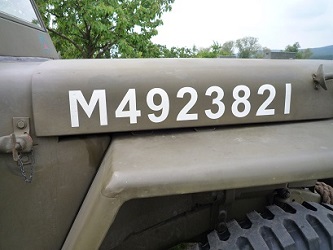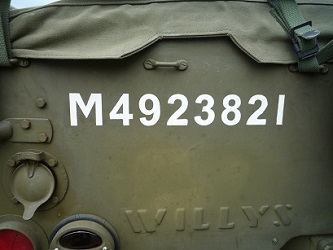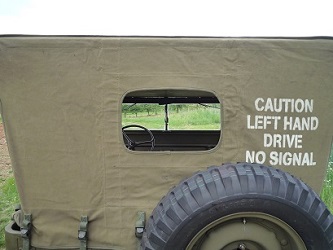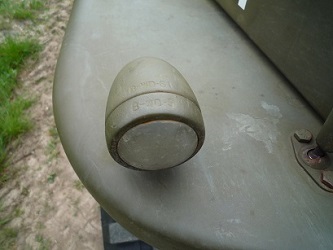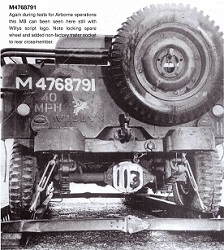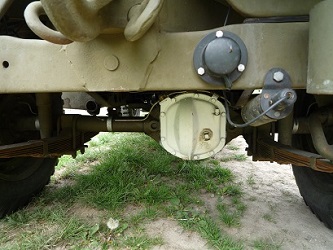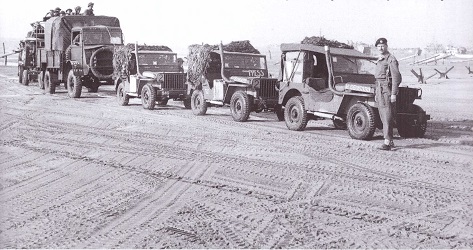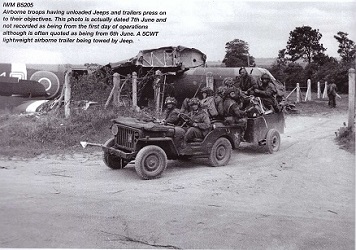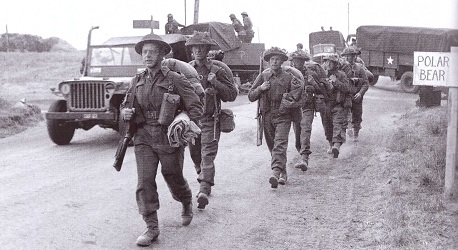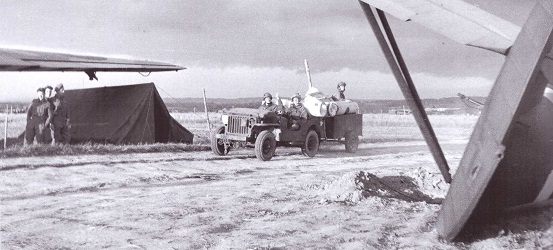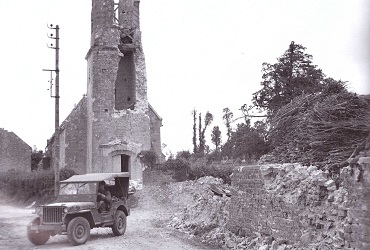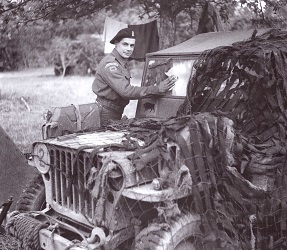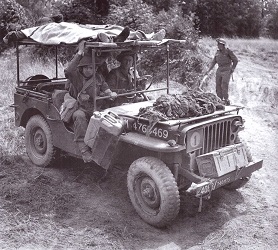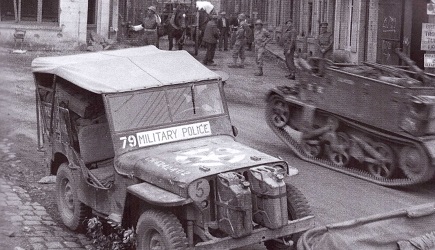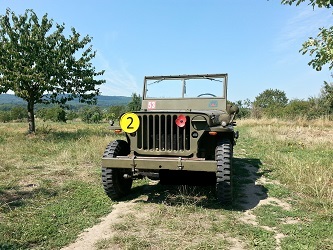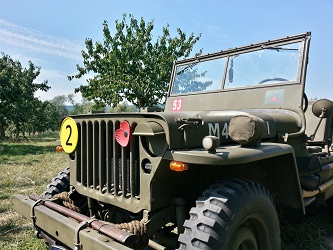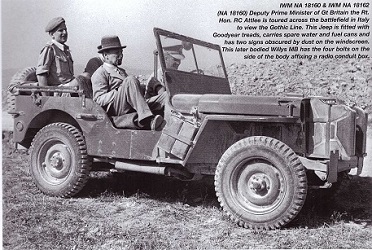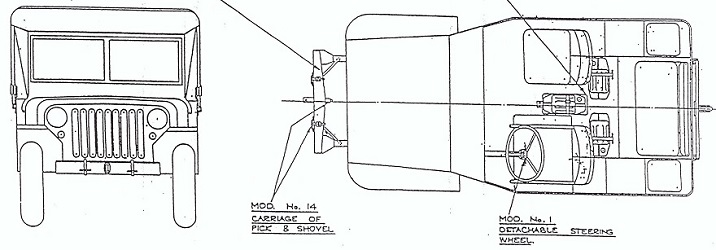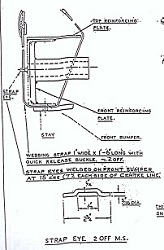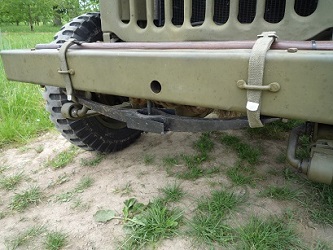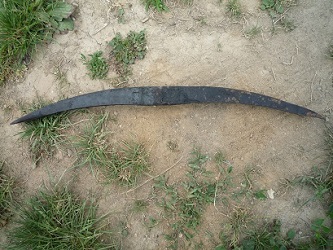In this section the british details of the jeep will be explained.
The book "The evolution of the Willys-Overland MB Jeep, Volume 1" by Lloyd White includes an interesting chapter about the Export of MB Jeeps
from the United States to other countries.
"Any physical modifications or changes to these BRT MB's were done by the British upon receipt. As far as Willys was concerned, these jeeps were
standard production MB's [...]. These contracts were fulfilled with both slat grille and stamped grille MB's." (WhV114, p.369). "The pre-D-Day
build up in England started in 1942 and continued through the summer of 1944. During this time many vehicles were using the British roads and so they
had to comply with road safety laws. Jeeps that were transferred from the U.S. Forces that went directly to Europe with the British saw less need for
some of the modifications such as moving the blackout lights out of the grille." (WhV114, p.370)
The chapter also includes a enumeration of british modifications.
"Modifications called out in July 1942 drawings are:
- Stowage brackets added to the back side of each fender.
- Rifle clips added to the windshield.
- Mirror moved to the passenger side.
- Moving the blackout marker lights to the fenders from the grille to comply with road safety rules.
- Adding an extension to the spare tire carrier for stowage of camouflage netting.
- Hooks were added between the bumperettes for safety chains since the rings were not on the early jeep pintle hooks (this is a best guess).
- Painting the rear axle cover white.
- Convoy blackout light installed on the rear cross member to illuminate the axle cover.
- Light switch added to the rear panel above the right bumperette to operate the convoy blackout light.
- The left head lamp was hooded.
- The right headlamp was covered with a bridge classification disc designating the gross weight of the loaded vehicle, with and without a trailer.
- The "Mickey Mouse" pattern camouflage was dictated by the command of that Regiment." (WhV114, p.371)
General british markings
Like I outlined in section MB158963, the chassis originally belonged to an american contract. But because of the history
of Winterswijk I wanted restore it like a british jeep. Therefore I had to find a brish serial number.
Like the US jeeps were marked with certain markings, this also applies to British jeeps. Nevertheless the markings differed from the US ones. Again the book
of Lloyd White "The evolution of the Willys-Overland MB Jeep, Volume 1" gives some interesting information:
"The British directives for Administration of Motor Transport were very specific regarding markings. This is a series of directives called A.C.I.'s
shich stands for Army Council Instructions. The jeep falls into the category of left-hand drive vehicles and the guidance is that the War Department
census number will be painted in white and will be located on the right side of the hood and on the rear panel. The dimensions for the numbers and
letters are 3 1/2" high, 2 1/2" wide and 5/8" thick." (WhiV114, p.370).
Knowing the position of the registration number on the jeep, during the restauration I had to decide, which serial number I wanted to paint onto
the hood and the rear panel.
"Publications authored by the British and Commonwealth forces refer to the MB (and GPW) as "Car, 5 CWT". This simply means five-hundred weight or 500 pound
capacity which equates to 1/4 ton. [...] British War Department vehicle numbers began with an 'M'. The M designated Car, 5 CWT. This was not limited to jeeps;
it addressed any vehicles in this weight class. There is no correlation between the U.S.A. registration number and the British census number. The British
number was assigned to a block of jeeps that were either new or reconditioned." (WhV114, p.374). This information shows the general pattern behind the
British registration numbers.
In order to determine a proper registration number, I looked for British registration numbers around the dod of MB158963 in Mid-July 1942.
The second book of Farley states that in July 1942 there also was an "ongoing contract: British Army from June SM2428. Chassis Range: MB155101 - MB156497.
Registration: M4923602 - M4923996" (Farl09, p. 58).
The quote shows, that MB158963 does not belong to the quoted chassis range. Nevertheless it seems to be the british contract, that lies closest to MB158963. Thus, I decided to use
a registration number from this contract and finally I arbitrarily used the registration
M4923821.
The following pictures show the registration number on the hood and the rear panel.
Beside the registration numbers also other markings were characteristic of British jeeps. "The label "Caution - Left-Hand Drive - No Signals" will be
applied in white 2" letters on the rear (most applied this to the canvas top)." (WhV114, p.370).
I also applied this marking to the back of my canvas top, like the following picture shows.
Position lights (modification #4)
Convoy light (modifications #7 to 9)
The following picture shows a jeep with a convoy light.
One can see the white rear axle cover (modification #7). Furthermore here the light switch for the convoy light can be seen (modification #9).
In this case the switch is mounted to the rear panel above the right bumperette.
The next picture also shows a jeep with a convoy light.
In this case again the white rear axle cover is apparent. Under the rear cross member the convoy light can be identified (modification #8). The
light switch for the operation of the convoy light in this case is installed onto the rear cross member.
The following picture shows the convoy light installed on MB158963.
Head lamps (modifications #10 and 11)
The following pictures show the bridge classification disc (modification #10) which covers the head lamp on the passenger side. On the driver side the hooded head lamp (modification #11) can be seen.
I decided also to install these two modifications. The pictures below show the result.
Jerry can
Like I outlined in section (dod-related details), the jerry can carrier on the rear
panel has not yet been introduced at the dod of MB158963. Nevertheless there is a multitude of pictures showing jerry cans fitted to
other parts of the jeep.
Some time ago I got a very nice 1941 british "flimsy" jerry can from a good friend.
The following picture shows a nice picture, where two jerry cans are fitted to the back of the right fender.
Pickaxe
According to the first book of Lloyd White the pick belongs to the Airborne modifications:
"Airborne 'Basic' modifications:
| [...] | |
| 2. Mounting the shovel and pick mattock on the front bumper (pick head goes underneath the bumper) | |
|
[...]" (WhV114, p.371) |
| "[...] | |
| 14. Pick and shovel to be fitted on front bumper. Pick head positioned under bumper. | |
|
[...]" (BaMe01, p.7) |
In fact I have not been successfull in finding any wartime picture with the pickaxe installed.
The following pictures shows the installation of the strapeyes on the front of the bumper for the straps.
The picture shows an airborne jeep. A close look to the front bumper shows the two straps around the bumber, which are used to attach the shovel and pick handle on top of the bumper. Nevertheless the pickaxe is missing on the picture.
Although the 4th R.W.F. did not belong to the airborne units, I decided to install the pickaxe on the front bumper.
The following picture shows the pick handle mounted on top of the bumper with two standard british straps. The straps are fixed with two standard
footmanloops. The pick head is fixed under the bumper.
Fortunately I found a very nice pickaxe. It is origanally marked 1943 and with the british war department arrow.

